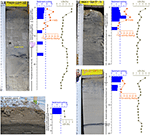
Geophysicist and geologist John Tuzo Wilson recognized that the offsets of oceanic ridges by faults do not follow the classical pattern of an offset fence or geological marker in Reid's rebound theory of faulting, from which the sense of slip is derived. Transform boundaries are also known as conservative plate boundaries because they involve no addition or loss of lithosphere at the Earth's surface. A smaller number of such faults are found on land, although these are generally better-known, such as the San Andreas Fault and North Anatolian Fault. This is a result of oblique seafloor spreading where the direction of motion is not perpendicular to the trend of the overall divergent boundary.

They accommodate the lateral offset between segments of divergent boundaries, forming a zigzag pattern. No lithosphere is destroyed or created, and mountain chains are not built at transform boundaries. Shear stress operates at transform boundaries, which involves sliding motion. Plate boundary where the motion is predominantly horizontal Diagram showing a transform fault with two plates moving in opposite directions Transform fault (the red lines)Ī transform boundary occurs when two tectonic plates move past one another.


 0 kommentar(er)
0 kommentar(er)
